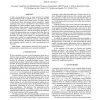Free Online Productivity Tools
i2Speak
i2Symbol
i2OCR
iTex2Img
iWeb2Print
iWeb2Shot
i2Type
iPdf2Split
iPdf2Merge
i2Bopomofo
i2Arabic
i2Style
i2Image
i2PDF
iLatex2Rtf
Sci2ools
ICASSP
2011
IEEE
2011
IEEE
Spatially-correlated sensor discriminant analysis
A study of generalization error in signal detection by multiple spatially-distributed and -correlated sensors is provided when the detection rule is learned from a finite number of training samples via the classical linear discriminant analysis formulation. Spatial correlation among sensors is modeled by a Gauss–Markov random field defined on a nearest neighbor graph according to inter-sensor spatial distance, where sensors are placed randomly on a growing bounded region of the plane. A fairly simple approximate expression for generalization error is derived involving few parameters. It is shown that generalization error is minimized not when there are an infinite number of sensors, but a number of sensors equal to half the number of samples in the training set. The minimum generalization error is related to a single parameter of the sensor spatial location distribution, derived based on weak laws of large numbers in geometric probability. The finite number of training samples ...
Related Content
| Added | 21 Aug 2011 |
| Updated | 21 Aug 2011 |
| Type | Journal |
| Year | 2011 |
| Where | ICASSP |
| Authors | Kush R. Varshney |
Comments (0)

